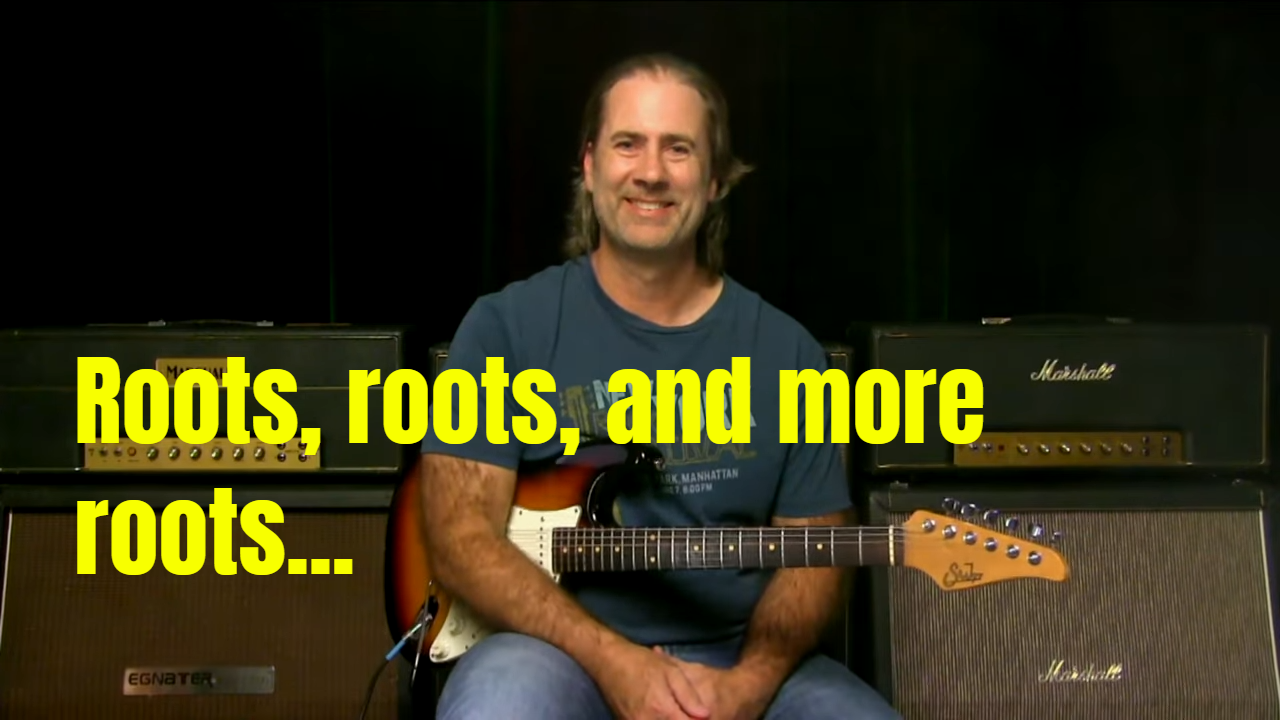When you solo over a blues there are a lot of root notes to think about…
There’s the “root” of the key…
There’s the root of the I chord, the root of the IV chord, the root of the V chord…
So which ones matter and which ones can you ignore?
I’ve got all the answers here for you:

12 replies to "A Root By Any Other Name"
You can also change to the root note of the 4 and 5 chords as they come along and still remain in the original pentatonic scale. For instance, box 1 of the A minor pentatonic is at the fifth fret. Go up five frets on the first string to the 10th fret (D) and play box 3 of the A minor pentatonic. Two more frets up on the first string take you to E, where you play box 4 of the A minor pentatonic. So, you remain in the original scale as you emphasize the roots of the 4 and 5 chords on the first string. Works for any key.
Great lesson and a good refresher.
I practice mostly the Minor Pentatonic scale across the 5 boxes whenever I am watching TV with my wife who is not well. No AMP. Fortunately for me, I am in a Band as Rhythm Guitarist & part time singer and some songs of Lead Rhythms & 12 Bar Blues. If I play short solos in a Maj Key of the song, I have to be mindful not to play minor notes, is this true? as sometimes I do play minor notes because it sounds good. This lesson is really a game changer. I love Blues Guitar playing, but in a Band we only play a few songs Blues based like Chuck Berry, etc. So some very versatile Set Lists.
It would be good to see more about this lesson with maybe a few solos across both Maj & Minor Roots soloing, with TAB.
Take Care
Michael-Sydney -Oct 21, 2025
Thanks Griff! Always heard you say you can only use the major over the 1 chord but I didn’t know technically why, except it never sounded right. Never realized that the 4 chord and the 5 chord were just not in the Major pentatonic scale. Helps to free up my brain-lock🤪
Basically because we can’t play all the notes in an E13, we don’t have enough strings or fingers. You could call it E9 add 13, to be more technically correct since we aren’t playing the 11, but the E13 is just common usage and most guitar players will know what you’re talking about.
Griff, great video, thanks. What piqued my interest most was your mention of mixing the major and minor pentatonic. I read an interview years ago in Guitar Player mag where the author talked about Clapton effortlessly moving between the maj and min pentatonic in his iconic Crossroads solo. I have looked fairly closely at the solo and never quite understood where he was switching between the two and when you can or “should.” It would be HUGE if you could teach us how to move between the two scales in the context of that song (and other Cream songs)! Perhaps it will culminate in a new and very popular course for you, b/c like modes, this area is not well understood by most.
Please also provide any links to moving between the two scales since unlike most other teachers you know how to explain complex things in fairly simple terms for your target audience. Thanks! 😎
Maybe check out these courses of Griff’s:
Sunshine of your love workshop
Cream era Clapton soloing workshop
Major minor blues shapes
And the Clapton solo in Lessons From The Masters
Thanks. I have the latest Clapton course by Griff (and I believe another Clapton course—need to check my acct)…haven’t gotten to it yet but am very interested to get into it. What’s “Lessons From the Masters?” Do you have a link to it? I appreciate it.
Yes…that really frees up the headspace!!
Great lesson Griff! You explained this so well and easy to understand! Cleared up a question I have had for a long time. Thanks so much!!
Dave
When you showed the D9, the E9 or E13 why is the E13 called just anE13 and Not E9/13?what I mean You’re still using the E9 shape and adding the 13 …not a big deal just curious as to the proper way to call out a chord if explaining it to someone else …like can’t I play an E13 in a regular A root bar chord shape also? Which if I’m correct would then technically be just the “E13” cause only the 13 is added or used as a replacement …or am I over thinking again, like I tend to do ?
Technically an E13 contains all the extensions: b7, 9, 11 & 13.
Since we can’t play them all at once on the guitar we can leave the 11 out.